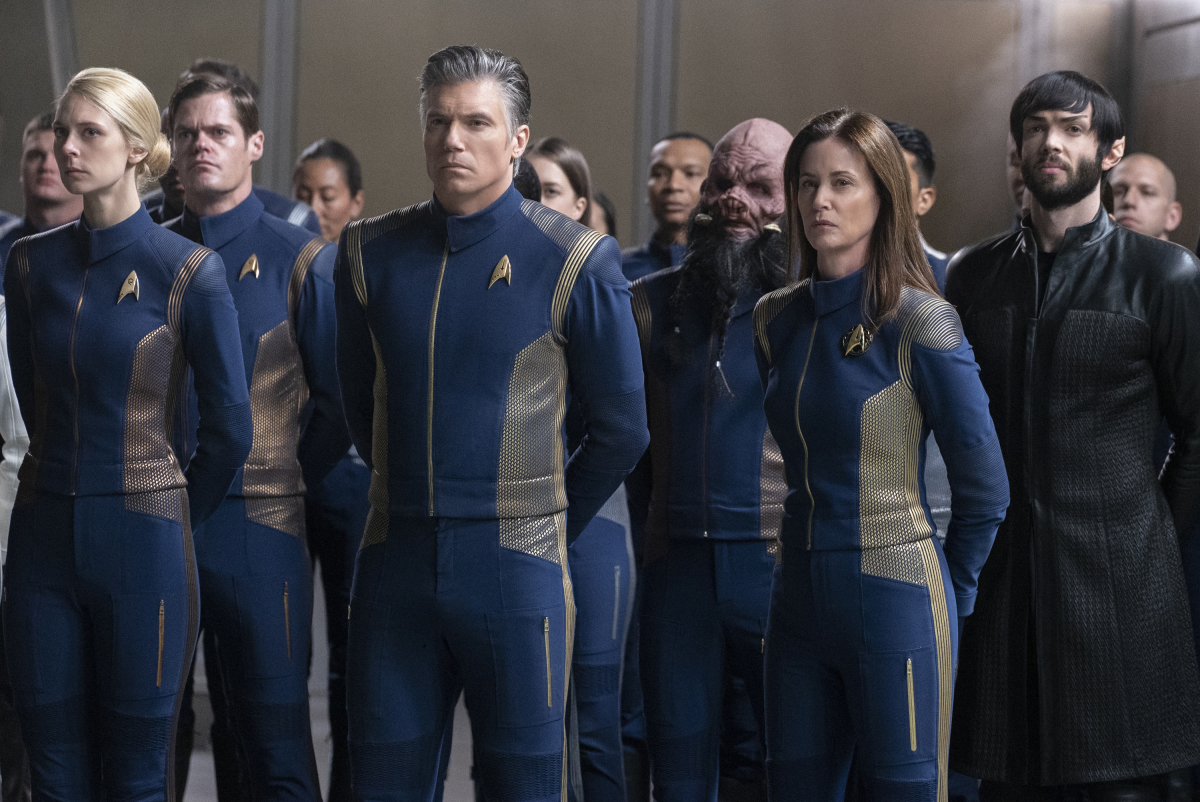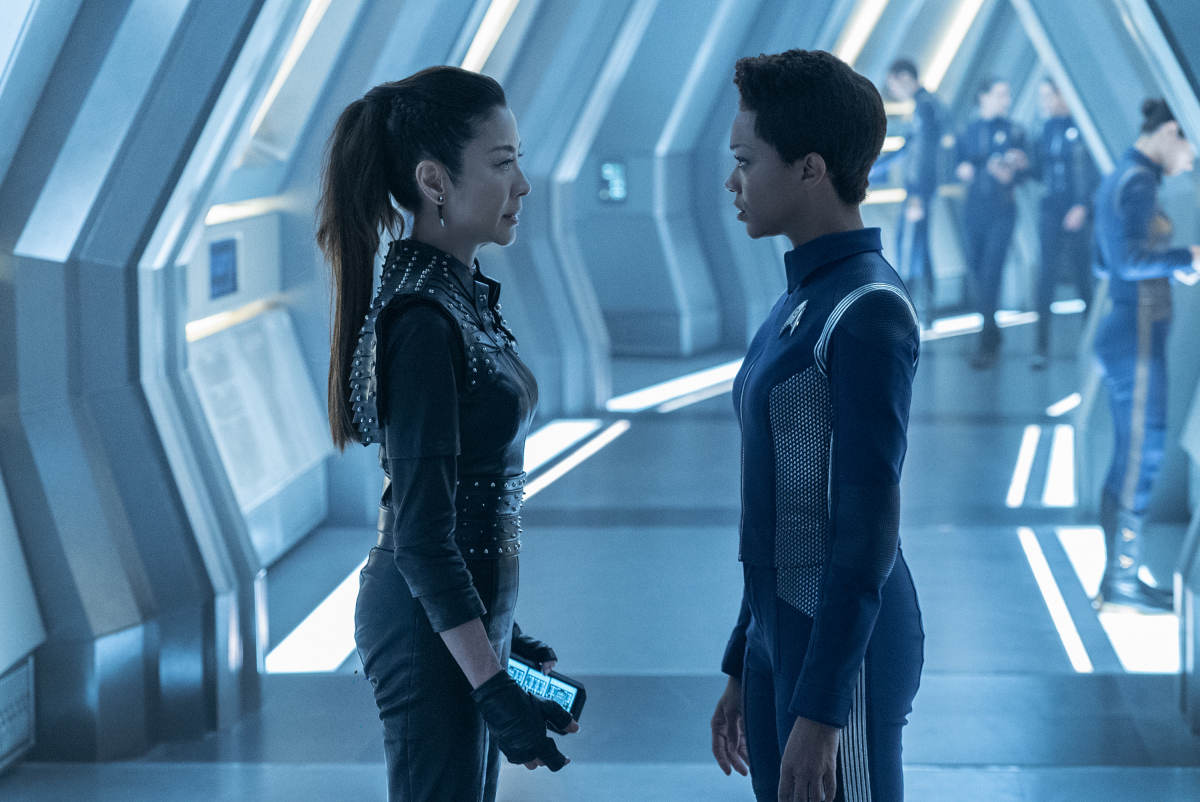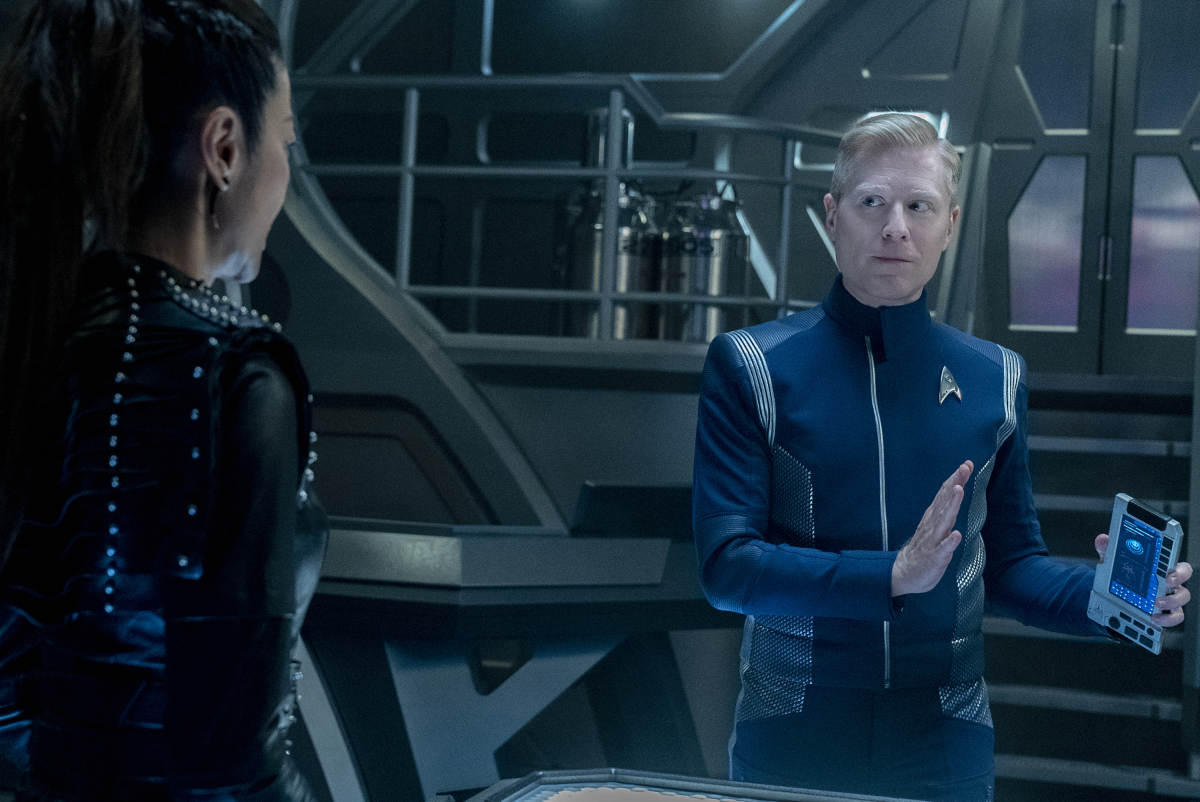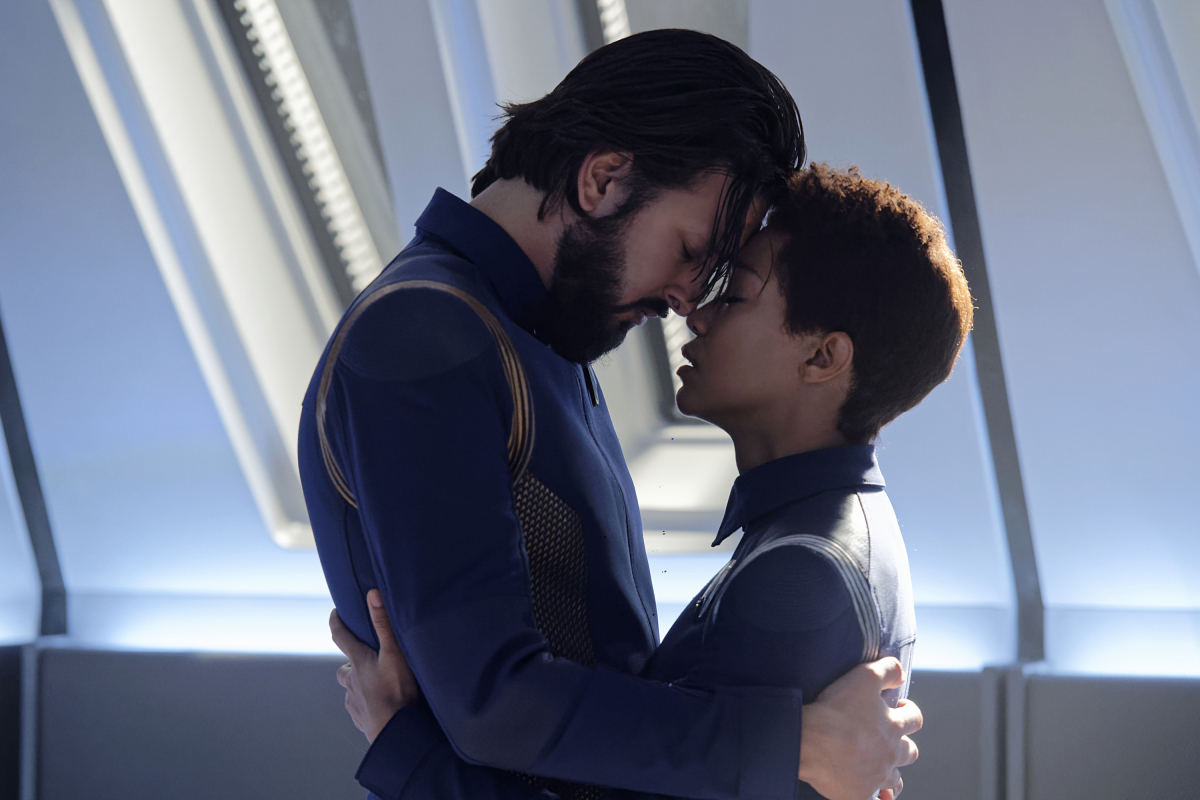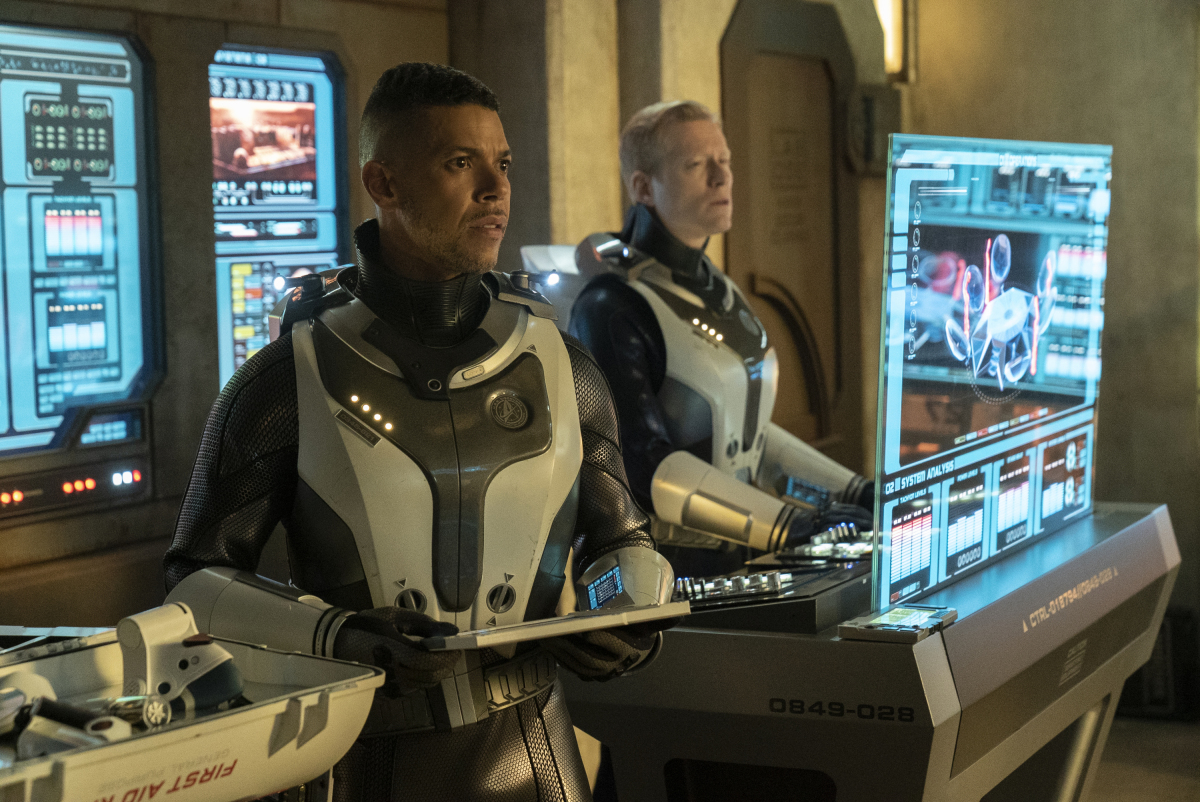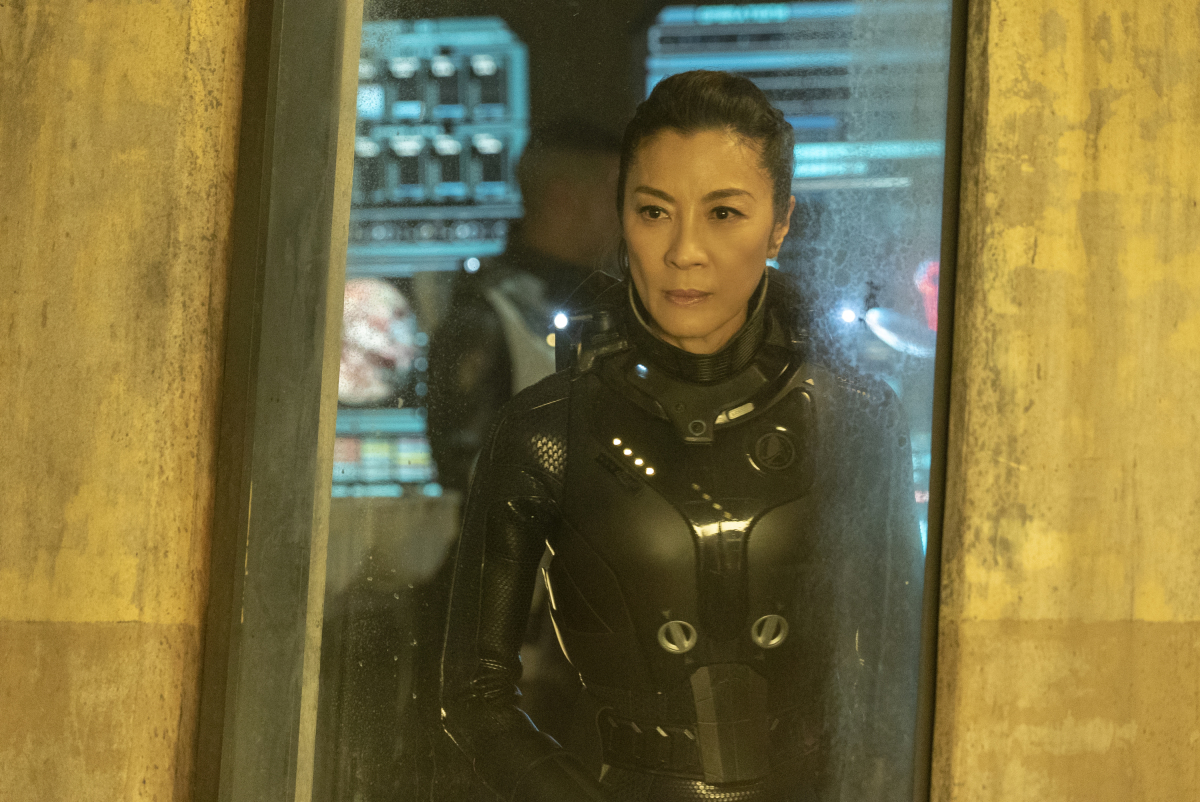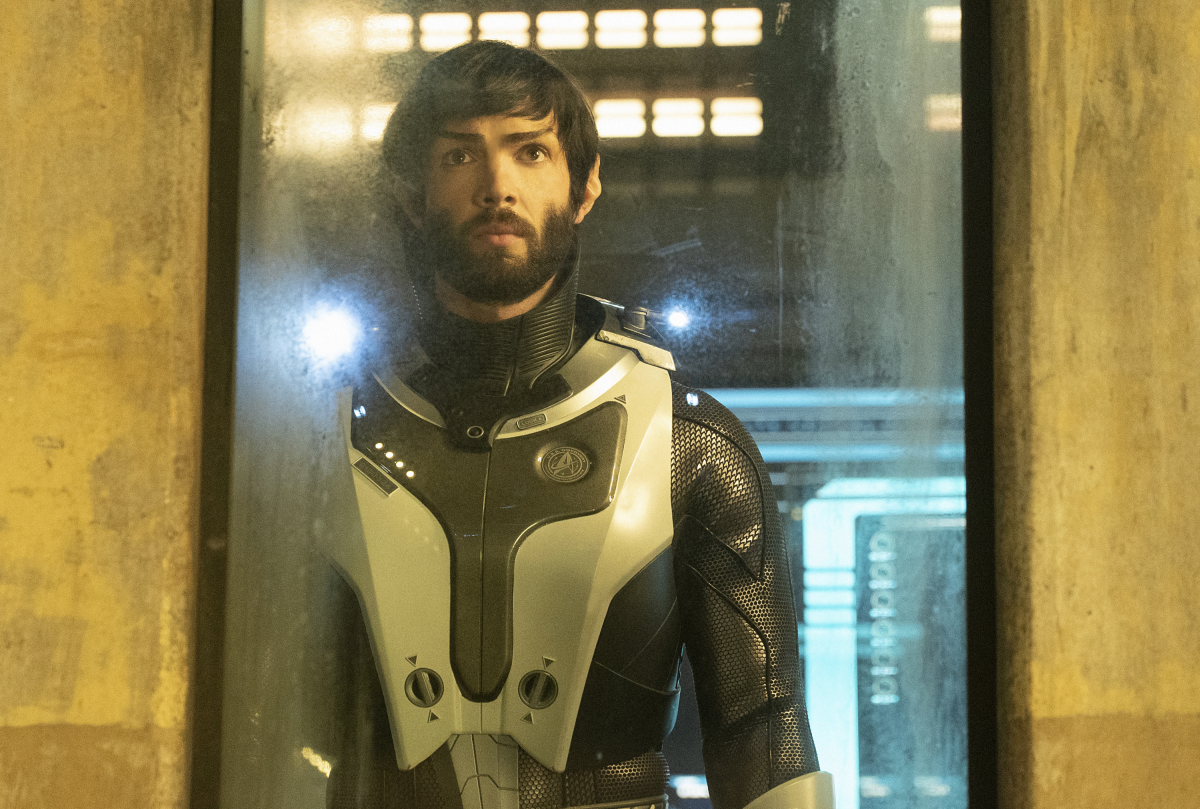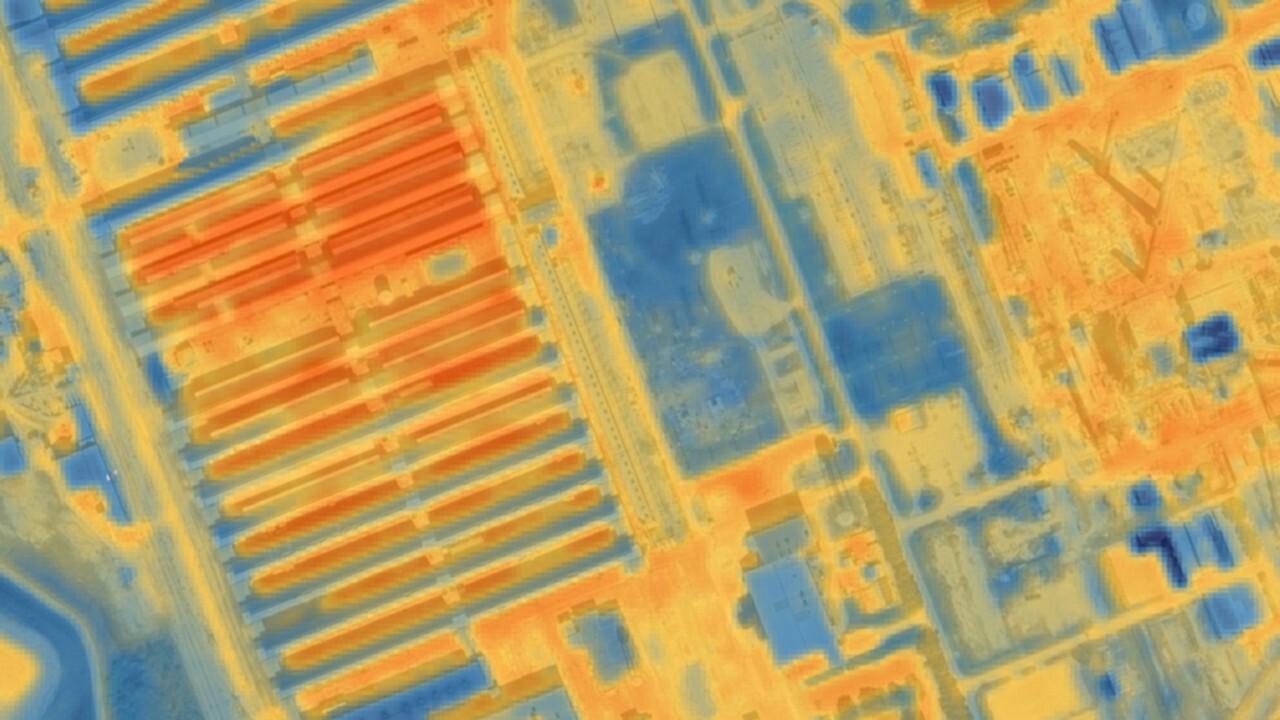The Identity of the Mysterious Red Angel Is Revealed in This Week's 'Star Trek: Discovery'
Tissues on standby as we get some powerful performances in this week's episode.
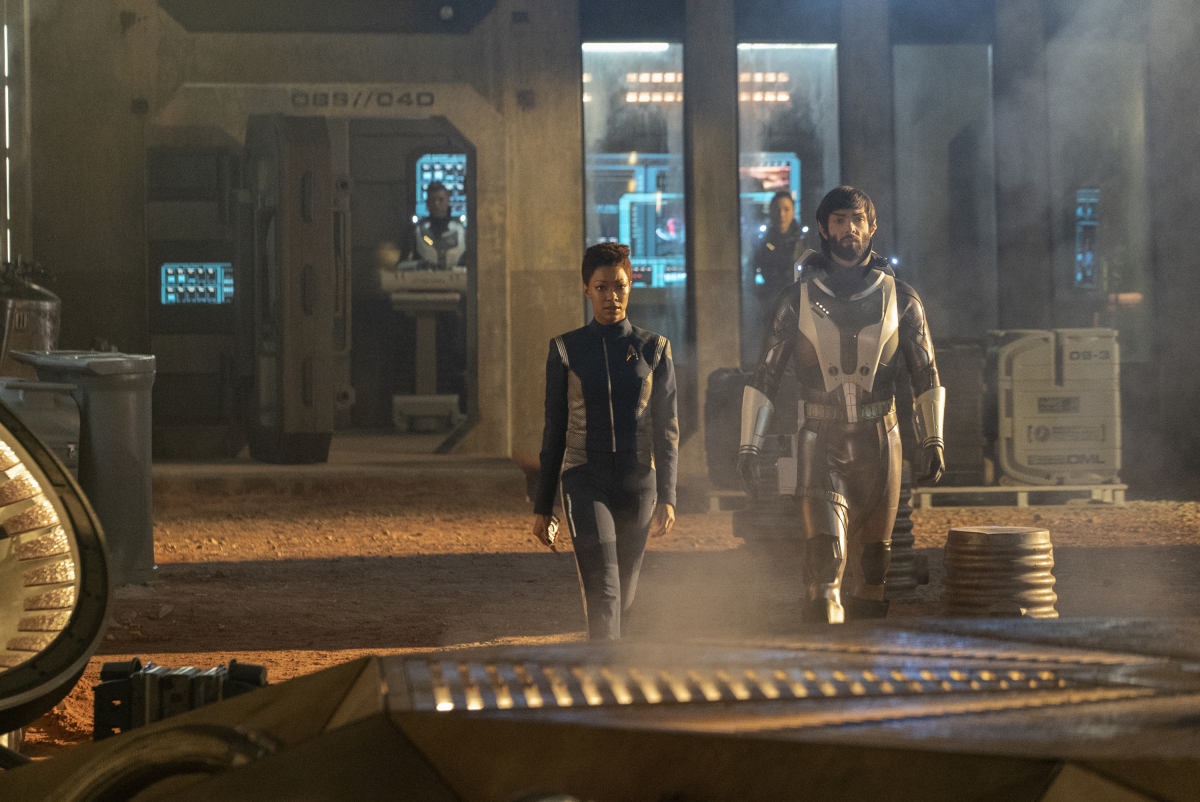
Set spoilers to stun…
Last week, we looked at a couple of the fan theories that we agreed with, at least in part, regarding the identity of the Red Angel … and this week, we found out if we were right. But we'll come to that later on. Given that this week's episode is titled "The Red Angel," there was a pretty good chance we'd learn something significant about this mysterious entity.
In an episode that's heavy with emotional performances, you'll find yourself reaching for the tissue box basically from the very beginning. We begin with the funeral of Lt. Cmdr. Airiam (Hannah Cheesman) taking place in the shuttle bay with the whole crew gathered. It's well-handled and many of the senior officers share kind, thoughtful words. However, we suspect they didn't go to all this trouble after Lt. Connolly (Sean Connolly Affleck) unceremoniously slammed into an asteroid in the season premiere. Perhaps he just wasn't very popular.
Related: The Evolution of 'Star Trek' (Infographic)
A big focus of this episode is the attempt to reconcile the relationship between Cmdr. Burnham (Sonequa Martin-Green) and Lt. Ash Tyler (Shazad Latif), and it begins immediately after the funeral. A large focus of this subplot is that Tyler did not send the unauthorized, encrypted subspace transmissions he was accused of sending; that was Airiam, acting under the influence of malicious code sent to the Discovery computer by the modified probe/squiddie in "Light and Shadows" (S02, E07).
There's some nice dialogue between Burnham and Tyler throughout the episode, as she feels guilty for having blamed him. But she still struggles to let him back into her life, because she feels he's abandoned his morals to work for Section 31.
Adm. Cornwell (Jayne Brook), Capt. Pike (Anson Mount), Cmdr. Saru (Doug Jones), Lt. Spock (Ethan Peck) and Burnham review everything they know regarding recent events. The artificial intelligence is from the future; it infected Airiam and forced her to copy some of the data transferred over from the dying Sphere so Control could evolve. However, this was prevented and Discovery destroyed the former prison and HQ of Section 31 following the events of last week's episode.
Breaking space news, the latest updates on rocket launches, skywatching events and more!
Cornwell asks a very pertinent question: "How could a Section 31 program designed to eliminate threats become the threat?"
To which Spock replies, "Time travel. The one variable we cannot possibly predict is the future. And clearly that AI is built on technology that we have no understanding of."
Of course, even though Airiam is dead and the Section 31 HQ and Control were destroyed, that doesn't mean that remnants of the AI aren't lying dormant somewhere undetected.
At this point Ensign Tilly (Mary Wiseman) bursts in and plays the clown yet again. Tilly explains that she discovered a hidden file, before Airiam's memory was deleted, that contained details of Project Daedalus and a bio-neural signature of the Red Angel.
"Michael … it's you," she says. And the opening credits roll.
Dr. Hugh Culber (Wilson Cruz) confirms that the bio-neural signature matches Burnham's, and Pike asks what everyone is thinking: Will Burnham wake up one day, discover time travel and take it upon herself to save the galaxy? Spock remarks, "That supposition does fit her emotional profile rather precisely, particularly her drive to take responsibility for situations often beyond her control."
A Section 31 vessel brings Georgiou (Michelle Yeoh) and Capt. Leland (Alan Van Sprang) to the Discovery, where we learn that Project Daedalus was a concept being developed by Section 31, naturally. Apparently, 20 years ago, the Federation learned that the Klingons were researching time travel, which would've meant, if they succeeded, they could effectively delete the human race from existence. Consequently, a temporal arms race began, and to gain an advantage, the Federation conceived the Daedalus Project. Yes, the Red Angel is of Federation origin.
Section 31 thought Klingon spies had destroyed the suit. But once it started appearing along with the red burst signals a short while before the events of this episode, Starfleet’s black ops division began working on a way to capture it and the individual using it. And so a plan is hatched.
Down in engineering, Lt. Stamets (Anthony Rapp) works with Georgiou and Tilly to disable the Red Angel's graviton emitter beam using the phase discriminators, or something, thus preventing it from escaping back through its time wormhole once it's captured.
And then there's this really weird scene in which Culber enters and Georgiou attempts to make Stamets feel uncomfortable. She describes how, where she comes from — the mirror universe — both he and Culber are "pansexual" and she had relations with them on many occasions. You can see what they're trying to do with Georgiou: to establish her as someone deliciously wicked and further flesh out her character as a temptress who walks a fine line between good and evil — especially since she's supposed to be getting her own spinoff series. But this scene feels out of place and jarring, with unconvincing dialogue.
The crew determines that their Angel-catching plan is going to require massive amounts of energy. But thankfully, one of the Daedalus Project test sites on Essof IV has the materials needed to construct a plasma reactor that will do the job.
Burnham confronts Leland about the information he's not volunteering, and credit to him, he tells her about her parents' death. We'd been led to believe that he was in some way responsible, and either this scene needs to be rewritten, or it should be stated that he's at least not directly responsible. Turns out that Burnham's mother and father actually worked on Project Daedalus. The Klingons attacked the installation and they were, apparently, killed. Leland says it was because he was young, inexperienced and hadn't taken enough precautions. Well, Burnham started a war.
A lot of characters in "Star Trek: Discovery" seem to suffer from unnecessary guilt complexes and blame themselves for all manner of things, some of which, as Spock said earlier, are situations simply beyond their control. Leland's redundant remorse is overshadowed, though, by two epic right hooks that Burnham unleashes on him, leading to a very bloody nose.
If the writers are going to make Leland responsible for this monumental event in Burnham's life, they should make him completely responsible. Create a story where he made a conscious decision that he knew could have resulted in their deaths. This feels like the writers wanted Burnham, and the audience, to be able to blame Leland, but not too much, because that might make him too evil.
Another puzzling element in the episode is that the crew are attempting to catch someone they’ve learned is a future version of someone participating in the plan. Wouldn’t they guess that the Red Angel, as future Burnham, might know about this plan to capture her and try to avoid it? Surely, this is a pertinent issue that anyone who passed The Trouble With Time Travel 101 at Starfleet Academy would have picked up on? No … guess not.
Related: How Time Travel Works in Science Fiction (Infographic)
Burnham confronts Tyler and blames him for not telling her about her parents' death, even though he didn't actually know.
In an interesting scene that had considerable potential, Culber goes to speak with Cornwell in her quarters, since she used to be a therapist. Despite an awkward initial exchange, this could've offered some new insight into both of their characters. We get a few minutes of deeply personal dialogue, but it still feels like an opportunity was missed.
Burnham continues to struggle with the news of how her parents died, and Spock makes an effort to talk to her; they share a nice exchange in the Discovery's gym, where she's is continuing to vent her frustration on a punching bag.
After their discussion, it occurs to Burnham that the Red Angel has appeared when her life was in danger, so it stands to reason that they should place her in a life-threatening situation to lure the Red Angel into their trap. Since the Discovery was already on its way to Essof IV, they decide to set the trap there.
Burnham will be seated, strapped to a chair in the center of a chamber with life support disengaged, and the poisonous atmosphere of the planet will be allowed to fill the room. She will be surrounded by the phase discriminators, electromagnetic pulse generators and everything required to snare the Red Angel and hold her in place. Naturally, no one is particularly happy about this potentially hazardous plan, least of all Pike and Tyler.
The drama for this climactic third-act finale is steadily built and nicely paced and features the best scene in this episode, where Burnham and Tyler have an emotional exchange in his quarters. The dialogue is well-written and well-acted, and it shows that they both still have feelings for each other, regardless of everything that's happened. You'll be reaching for the tissues again.
Everything is set. Spock, Stamets, Culber and Georgiou are behind a protective window in a room adjacent to the chamber, monitoring Burnham's life signs. Pike, Tilly and everyone on the Discovery are also monitoring every variable, including tachyon particle levels that might indicate the arrival of the Red Angel. Aboard the Section 31 ship, Leland is keeping a watchful eye on power levels. Burnham is strapped in, the air is sucked out of the room, and the poisonous atmosphere replaces it.
Everyone watching cringes as Burnham screams in agony, and it is remarkably well-acted. Her skin begins to boil off from her face as every onlooker struggles to overcome their own instinctive urges to save her instead of allowing this questionable plan of action to continue. Her vital signs steadily fall with no sign yet of the Red Angel, and Culber expresses concerns. Even Georgiou thinks it has gone on long enough, as Burnham spasms in her chair.
Spock, however, focuses on the logical side of this sacrifice: Burnham's life in exchange for potentially the life of every single sentient life-form in the galaxy. He draws his phaser and prevents anyone from entering the chamber. Burnham flatlines … just as Tilly picks up a massive spike in tachyon particles. The Red Angel has arrived.
In a swirl of light, the mysterious, winged figure focuses a beam of energy at Burnham's chest while the phase discriminators and electromagnetic pulse generators do their work, preventing the Red Angel from disappearing back through her time wormhole.
But more power is needed, so Leland must authorize an override of the safety protocols onboard the Section 31 ship. Growing impatient, he seems to lean in for some sort of retina-scan security clearance and makes an under-his-breath remark about the power increase not being that hard to do, when he suddenly gets stabbed in the eye with a long needle that shoots out from the retina-scan device as the computer simultaneously repeats his flippant remark in an eerie, electronic voice. He's left lying, barely conscious, on the metal floor. Poor Leland has had a rough day at the office.
Meanwhile, the Red Angel struggles at first within the trap and then finally concedes, having been successfully confined. Life support returns to the chamber, and Burnham appears to be alright. Everyone looks on with baited breath, unsure of what to expect, barely believing that they have finally captured this elusive time traveler.
A figure falls to its knees from the exosuit and pauses momentarily, before looking up and making eye contact with the still-strapped-in Burnham.
Burnham, still visibly in pain from the ordeal, looks down. Her eyes widen; her bottom lip quivers. Barely able to get her breath, she gasps, "Mom?!"
We'll hazard a guess that the AI from the future has successfully infiltrated the Section 31 computer system, since having a long, sharp, metal needle suddenly puncture your caruncle is probably not part of a normal security-clearance procedure. And as for Mrs. Burnham in the Red Angel suit, we said this might be the case.
So, here are a few thoughts as to how the next part of the plot might unfold. Cast your mind back to events in the excellent "Short Trek" episode "Calypso"; in the 33rd century, Craft (Aldis Hodge) is unconscious in a V'draysh escape pod and rescued by the Discovery, which has been placed and deliberately left for a thousand years in an ion storm. That storm isolated Discovery from any outside communications or computer uploads; in short, it couldn't be infected by any malicious code and would therefore be safe from the AI.
Has the Red Angel successfully prevented the war with the AI or, like in "Terminator 2: Judgment Day," just delayed it?
Think back to the best episode so far in this season of "Star Trek: Discovery" — "Eden" (S02, E02). That group of people were rescued by the Red Angel and placed on a world many light-years away from Earth. Is this planet the homeworld of Craft? In that episode, the inhabitants refer to the planet as Terralysium, but we learn that Craft is from Alcor IV. Perhaps it was renamed once the population learned more about the planetary system their world was in.
The writer of "Calypso," Michael Chabon, confirmed on Instagram that "V'draysh" is a syncope of "Federation" — a version of the word with some sounds omitted. This admission, and the fact that we learn that the V'draysh valued relics from the "Long Ago," an era of pre-warp Earth, suggests that this is what has become of Starfleet and the United Federation of Planets a millennium after the events of "Star Trek: Discovery."
We've mentioned before the theories of YouTube user Ketwolski, and we're inclined to agree with many of them. It's entirely possible, given how "Star Trek" showrunner Alex Kurtzman's mind seems to work, that the villager Jacob (Andrew Moodie) whom Pike befriended in "Eden" is a distant relative of Craft.
It's also possible that in this timeline, the Federation goes to war with the AI, much like the plot of the novel "Star Trek: Section 31 — Control," by David Mack. What's left of the Federation becomes the V'draysh, fighting to regain control of the galaxy they once governed. But the Discovery remains as an undamaged, unaffected buried treasure of sorts, with preserved data from when the Federation was still a force of good.
In addition, Sonequa Martin-Green gushed to the gathered crowd at New York Comic Con last year that her husband, Kenric Green, was going to appear in this season of "Star Trek: Discovery." What's most notable is not that he hasn't shown up so far, but that "Star Trek: Discovery" is not listed among his acting credentials on IMDb yet, a typical move done so as not to reveal any potential spoilers.
So, there could be three concurrent timelines in effect in "Trek" lore. First, there's the Prime timeline, which includes everything from every TV series except "Star Trek: Discovery." Then, there's the Kelvin timeline, which is everything that J.J. Abrams kindly brought to the franchise. And now, there's potentially the Burnham timeline, which is everything that happened from the moment her life was saved as a small girl on Vulcan — where, in the Prime timeline, she died.
This would explain, among many other things, why Spock never mentioned his sister before and why the spore drive was never seen. It means that CBS could theoretically remake every single series of "Star Trek" — with the exception of "Enterprise" — because, going forward, we're now in the Burnham timeline and they'd all be slightly different. From a merchandising perspective alone, a visual reboot like this equals big bucks.
And herein lies the problem. You now need an honors degree in "Star Trek" history just to understand the significance of events. Even the more hardcore "Trek" fans are getting a little fed up, so it's a little bewildering that the franchise expects more-casual fans to stay engaged. As a stand-alone, science-fiction drama that anyone can enjoy, "Star Trek: Discovery" has lost the plot a bit. To fully understand the implications of events you don't just have to watch earlier seasons of the same show — you have to watch entire seasons of completely different shows, as well.
Finally, in this episode, we get a weird, but not unwelcome throwback to Season 1. We see that Lt. Nilsson returns to the bridge to take Airiam's old position as ops officer just before Burnham transports down to the surface of Essof IV. We first saw Nilsson in the Season 2 premiere, and she's played by Sara Mitich, who played Airiam throughout Season 1, before Cheesman took over for Season 2. Mitich is listed on IMDb as appearing in the next three episodes at least, so we'll have to wait and see if she returns for Season 3.
Casting-wise, we also know that neither Pike nor Number One (Rebecca Romijn) will be returning to "Star Trek: Discovery" after this season. According to Deadline, the two actors only ever had one-year contracts with the show. In all honesty, we suspected this was going to happen, as Kurtzman has maintained throughout the show's development that the focus of "Discovery" was Burnham.
The first season of "Star Trek: Discovery" is available to stream in its entirety on CBS All Access in the U.S. and Netflix in the U.K. "Star Trek: Discovery" Season 1 is available now on Blu-ray.
The second season of "Star Trek: Discovery" consists of 14 episodes with no midseason break. It airs on Thursdays on CBS All Access in the U.S. and on the Space TV channel in Canada; the rest of the world can see the show on Netflix on Fridays.
- The 'Star Trek: Discovery' Crew Tries to Infiltrate Section 31's HQ in 'Project Daedalus'
- 'Star Trek: Discovery's' Ethan Peck Talks About Filling Spock-Size Boots
- Picard and Riker Reunite! Jonathan Frakes Will Direct New Trek Episodes
Follow Scott Snowden on Twitter. Follow us on Twitter @Spacedotcom and on Facebook.

When Scott's application to the NASA astronaut training program was turned down, he was naturally upset...as any 6-year-old boy would be. He chose instead to write as much as he possibly could about science, technology and space exploration. He graduated from The University of Coventry and received his training on Fleet Street in London. He still hopes to be the first journalist in space.
